Histoire
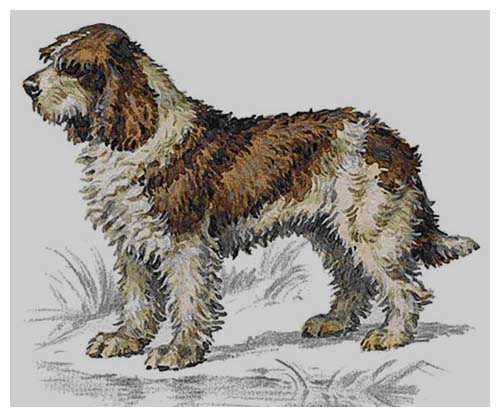
Barbet
Race de chiens d’arrêt, à poil laineux, excellents nageurs, utilisés autrefois pour la chasse aux canards. Son nom lui provient probablement à cause d'une comparaison de ses poils avec la barbe.
Le Barbet estt un chien d’eau pour la chasse à la sauvagine. Le Barbet, comme tous les chiens d’eau
est plus qu’un simple rapporteur, il doit rechercher et débusquer le gibier caché dans la végétation aquatique et le faire lever. Il rapporte ensuite la pièce tirée par son maître. Ne craint pas le froid,
va à l’eau par tous les temps.
Pour les Origines je vous suggère le lien internet suivant

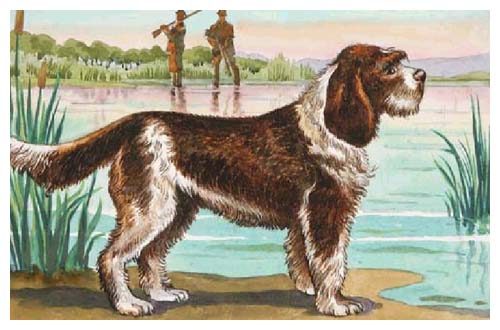
Vous pourrez lire la section Histrique : Les onglets découvrir, la généalogie, les origines récentes, moustache le Barbet, le chien pêcheur.
Un autre site qui est complet


The authentic Barbet / Old bloodlines
“The Barbet is not a spaniel, but a Griffon whose origins have been very much a topic of discussion...written in 1933, by M. Dhers for the Chasseur Français.
Stonehenge considered it was :
• a variety of poodle
• the result of a crossing of a spaniel and of the water spaniel
• a breed of its own
One could answer...
• the poodle came after the Barbet
• the water spaniel is a perfected Barbet
• that the 3rd option is most likely the most correct
It is most likely that the poodle is a descendant of the Barbet; and that the name canis aquaticus Linné had attributed to the Barbet, and not the poodle.
The Barbet having been the subject, historically, in our little canine world, of a major debate and continues to be, one needs to take a stand and decide as a breeder, aficionado or simple owner, what to believe and what not to.
Those of us who have signed the BREEDERS’ CHARTER for the AUTHENTIC BARBET believe in the 1894 standard written for a Griffon Barbet. We believe that a Griffon is not a Poodle. The poodle is a sophisticated, elegant dog with its own standard. Yes, it is a descendant of the Barbet, but selected for another purpose : refinement and elegance.
We don’t support any radical standard changes as there have been, in such an old French breed. The Barbet is a Griffon that was transferred into the SCC group 8 because of its remarkable ability to swim. It is and must remain a rustic, all around dog, that can retrieve from water and hunt on land, when trained. The Barbet also excels in agility and is a very intelligent dog who learns very quiclky. The Barbet is also a lovely, affectionate companion who does need space and activity. He is a member of the family!
Why “authentic” Barbet?
As a revamped logo will be posted on our sites, we would like to stress our will to continue the phenotype / appearance of the Barbet from the 30’s, as documented in many books and photographs. If some still have a bit of Barbet blood in them, we wish to promote it and continue to strive towards the morphology, natural (retrieving and hunting) ability, character, health, the multitude of colors that make the Barbet special, and a rustic, sound animal as there were documented to be at the turn of the 20th century and throughout most of the 20th century before some radical changes were made to the breed and its appearance and to the standard.
As a reminder, back in “those days” ther was no DNA (a medical test to confirm parentage by using saliva or blood), but when you looked at the dogs, you knew where they were bred and what breed they were. The Barbets, not SCC registered, had the appearance of a purebred dog and were admitted to the Titre Initial registry after having been seen by a judge of the SCC. Their origins can be traced through ownership.
How to achieve our objective? By selecting as much of what little Barbet blood still flows through the veins of some of the descendants of Mrs Pêtre’s dogs, and her father’s. The Barbets that have been selected so far, for reproduction, have been very similar to the old (blood) lines and very promising for the future of the authentic Barbet.
We also believe in communicating openly about the true pedigrees of our dogs and why we do what we feel needs to be done for the future.
We would like to put our competencies at the disposal of those who share our values and are interested in joining our community, working towards our target which is the survival of this wonderful French breed, please feel free to contact any of us. We will be happy to help you.
Below is a brief history of the Barbet from 1891 to 1970, when Mrs Pêtre, Dr Vincenti’s daughter, was offered a Barbet and decided to start breeding again.
The standard was written in 1891 by J de Coninck, president of the Société Havraise pour l’Amélioration des races de Chiens. He thought the Barbet was more of a water dog than a gundog. The Barbet was in the FCI/SCC 7th group until 1986 along with the Griffon Korthals of which he was one of the founding fathers along with the Griffon Boulet. He also participated in the making of the Berger de Beauce along with the Briard and the Poodle.
1920-1930 : Le Houelleur
M Le Houelleur, an SCC judge and hunter decided to acquire a Barbet and used him to hunt in the many areas of France he lived in and travelled through. He had already seen Barbets working in the Somme, the North of France, the Loiret, the Causses area and saw how quickly they adapted to the terrain.
He became a breeder. His kennel name was Floirac, town where their family home was and still is, in Dordogne where the family spends holidays and summers together to this day.
1930-1940: Le Houelleur/ Dr Vincenti
The kennel name ”Mas de la Chapelle”, was registered at the SCC in 1933 by Dr Vincenti.
The 2 dogs he used as foundation stock were Hourie de Floirac and Iff de Floirac from M Le Houelleur.
Hourie de Floirac
b. 15/8/33 out of Beseff de Floirac and Piram (Barbet that came from a kennel in the Somme area of France)
46cms/20kgs/coat white with black, wooly.
Qualities : hunted remarquably well, natural retriever, very intelligent, excellent model.
Iff de Floirac
b. 6/3/ 34 out of Beseff de Floirac and Piram
55.5 cms/wooly coat, black heads, white mustache, good nose, very affectionate
Defects : sometimes a bit stubborn, too tall, too good looking, too distinguished (!!!)
These 2 Barbets had 3 litters. Joyeuse was born in one of those litters.
39 pups were born in the Mas de la Chapelle.
Joyeuse du Mas de la Chapelle
b. 7/3/35
48.5cms/20.4kgs/wooly coat/ white with black on the croup/very intelligent, gay/expansive/ an ideal Barbet/ only problem could be that her head is not round enough. Joyeuse is probably the most well-known Barbet of that time because she was presented at many dog shows.
Dr Vincenti kept very strict records on each dog he produced in his kennel book that is available to us for perusal.
Example of overall remarks about the dogs : The dogs were white with black (as opposed to several of M Le Houlleur’s who were black with white). Good hunters/Very intelligent/flexible/ affectionate. Head length 20 cms/wooly coats/.
Records were kept on all the dogs as far as morphology (positive and negative points), colors, measurements, ability to hunt and character.
Unfortunately, as in other breeds, WWII did a lot of damage (and to dogs, too!) and it was difficult to find good quality dogs to keep the line going.
M Le Houelleur had sold his last barbet and stopped breeding in 1941, Dr Vincenti had died. In the North of France, the numerous Barbets were just about exterminated after the war. Just about doesn’t mean completely as it was known that there were still a few Barbets, mainly in the south of France.
No one, unfortunately has ever looked into what stock could be left in the north of France, Belgium or the Netherlands as it is a tidious and time-consuming task. No one can say either or prouve that the breed was extinct unless one has turned over every stone in the countries where there were Barbets starting at the beginning of the 20th century who most likely reproduced at some point.
1940-1960’s: They Ayme brothers
Very few births registered at the SCC, but a few doing their best so as not render the breed extinct. Barbet were used for hunting and not for attending dog shows. The document below was taken from M Hermans’ Club du Barbet review no.2
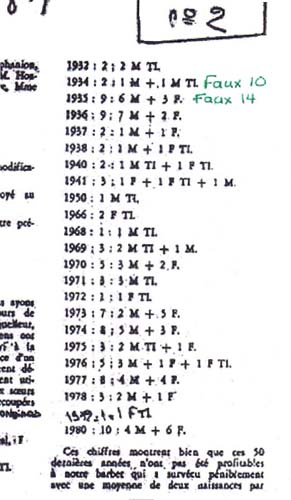
As far as the Barbet was concerned, breeding went forward for a few years with the Ayme brothers, who lived in the mas (Mas de la Musique), next to the Vincenti family’s Mas de la Chapelle. They were far away from paris and the SCC, and didn’t feel concerned with dog shows or beauty, the Barbet was a working hunter and that was their reason for being. Eventually, new blood had to be found as they were confronted to the inbreeding problem one has with not enough different blood. Thanks to Quesop (Portuguse water dog) brought back from Portugal, in a truck full of bulls! and mated to Bella, breeding was continued.
There are numerous family photos where the ressemblance with Dr Vincenti’s Barbets is striking. Ressemblance/ phenotype that was continued, for lack of genetic proof so necessary to some...
In the late 1960’s M Le Houelleur who had been corresponding with Miss Postigo wrote an article about the Barbet, published in the SCC official review.
In 1970, Miss Postigo who lived in Marseille and worked closely with the Ayme brothers offered Mrs Pêtre one of her father’s Barbets’ descendants named Thais. Mrs Pêtre decided to start breeding again.
S’Gandar was the son of Quesop and Bella from the Ayme brothers. They were mated.
Bella was the daughter of Thian and Tahio who in turn were son and daughter of Kino du Mas de la Chapelle and Lita.
And a long line of descendants was started. Some successful, some less as is the case with most breeders. Mrs Pêtre was helped in her endeavour by several willing people until the early 80’s, when.
M. Hermans had decided to re-incarnate the Buffon Barbet from 1776, by crossing T.I. dogs found in pounds with poodles and more poodles and discarding all of the Griffon Barbets in the south of France along with their breeders, descendants of Dr Vincenti and M Le Houelleur’s Barbets from the 30’s. The Barbet war had began and is ongoing to this date, 30 years later.
With facts, true history, original documents, photographs of lines and true pedigrees being made available to all of us, perhaps there will be a solution found at some point in the future. In the meantime, you as a reader, can make your own opinion and not rely on someone else’s.
For more documents and facts, please refer to :
Barbet : French National Treasure : http://bbfrenchtreasure.free.fr/index.php
The historians and canine authors referred to, for information and history include the following :
http://chiensdeau.free.fr/BarbetenBresse/articles.php?pg=art151
This document cannot be used, reproduced, modified or copied, even partially, without EXPRESS WRITTEN consent of the owner.
© Mrs Elaine Fichter August 10 2010
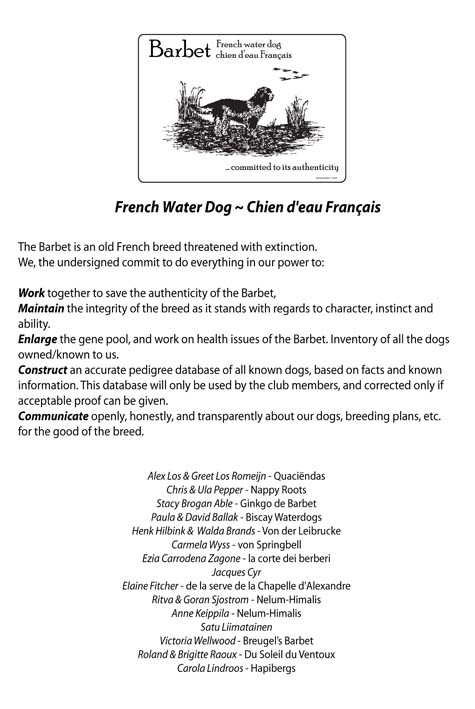
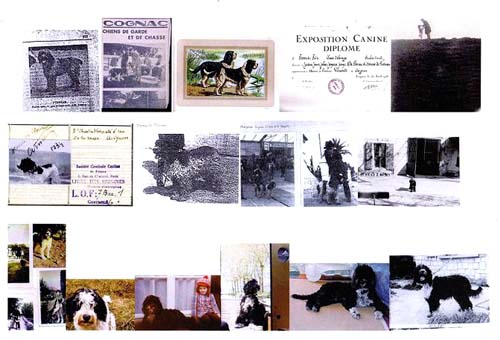
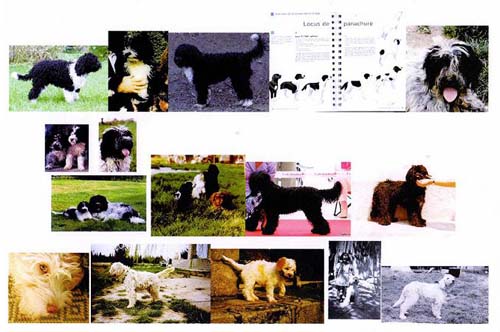
• Accueil • Barbet • Parenté • Prouesses • Portées • Standard •
• Histoire • Entraînements • Amis • Remerciements • Liens •
Conception : Marie-Christine Genest

|
